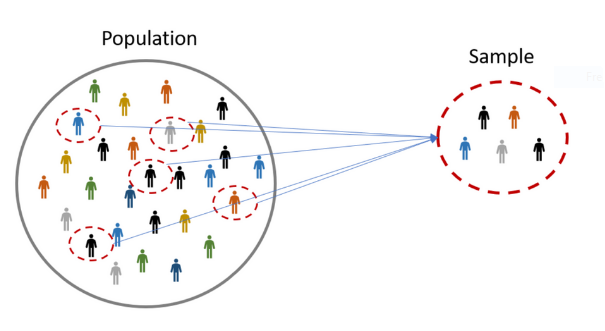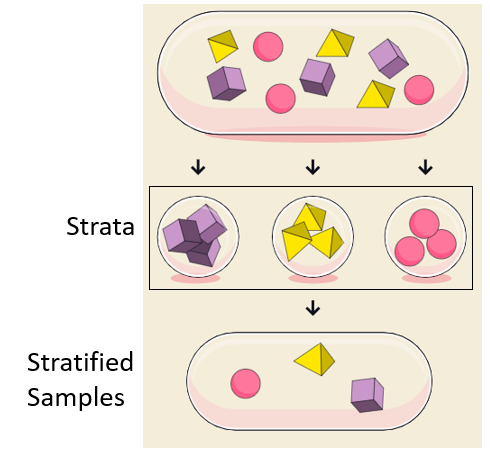Sampling Techniques

What is sampling ??
Sampling is a method that allows us to get information about the population based on the statistics from a subset of the population (sample), without having to investigate every individual Example: When you conduct research about a group of people, it’s rarely possible to collect data from every person in that group. Instead, you select a sample. The sample is the group of individuals who will actually participate in the research.

Advantages and challenges in Data Sampling
Sampling can be particularly useful with data sets that are too large to efficiently analyze in full — for example, in big data analytics applications or surveys. Identifying and analyzing a representative sample is more efficient and cost-effective than surveying the entirety of the data or population.
There are many benefits to sampling compared to working with fuller or complete datasets, including reduced cost and greater speed.
An important consideration, though, is the size of the required data sample and the possibility of introducing a sampling error. In some cases, a small sample can reveal the most important information about a data set. In others, using a larger sample can increase the likelihood of accurately representing the data as a whole, even though the increased size of the sample may impede ease of manipulation and interpretation.
Different Types of Sampling Techniques
- Probability Sampling: In probability sampling, every element of the population has an equal chance of being selected. Probability sampling gives us the best chance to create a sample that is truly representative of the population
- Non-Probability Sampling: In non-probability sampling, all elements do not have an equal chance of being selected. Consequently, there is a significant risk of ending up with a non-representative sample which does not produce generalizable results
Types of Proability Sampling
Simple Random Sampling
This is a type of sampling technique you must have come across at some point. Here, every individual is chosen entirely by chance and each member of the population has an equal chance of being selected. Simple random sampling reduces selection bias. Simple random sampling reduces the chances of sampling error. Sampling error is lowest in this method out of all the methods.
Cluster Sampling
In a clustered sample, we use the subgroups of the population as the sampling unit rather than individuals. The population is divided into subgroups, known as clusters, and a whole cluster is randomly selected to be included in the study. This type of sampling is used when we focus on a specific region or area. There are different types of cluster sampling — single stage, two stage and multi stage cluster sampling methods.
Systematic Sampling
Systematic sampling is a statistical method that researchers use to zero down on the desired population they want to research. Researchers calculate the sampling interval by dividing the entire population size by the desired sample size. Systematic sampling is an extended implementation of probability sampling in which each member of the group is selected at regular periods to form a sample. Systematic sampling is defined as a probability sampling method where the researcher chooses elements from a target population by selecting a random starting point and selects sample members after a fixed ‘sampling interval.’
Here are the types of systematic sampling:
- Systematic random sampling
- Linear systematic sampling
- Circular systematic sampling
Stratified random Sampling
In this type of sampling, we divide the population into subgroups (called strata) based on different traits like gender, category, etc. And then we select the sample(s) from these subgroups. We use this type of sampling when we want representation from all the subgroups of the population. However, stratified sampling requires proper knowledge of the characteristics of the population

Types of Non Probability Sampling
Convinience sampling
Convenience sampling (also known as availability sampling) method that relies on data collection from population members who are conveniently available to participate in study. Facebook polls or questions can be mentioned as a popular example for convenience sampling. Convenience sampling is a type of sampling where the first available primary data source will be used for the research without additional requirements. In other words, this sampling method involves getting participants wherever you can find them and typically wherever is convenient. In convenience sampling no inclusion criteria identified prior to the selection of subjects. This method of data sampling is typically used when the availability of a sample is rare and expensive. It’s also prone to bias, since the sample may not always represent the specific characteristics needed to be studied.
Judgmental or Purposive or selective Sampling
Judgment sampling, which is also known as purposive or selective sampling, is based on the assessment of experts in the field when choosing who to ask to be included in the sample.
In this case, let’s say you are selecting from a group of women aged 30–35, and the experts decide that only the women who have a college degree will be best suited to be included in the sample. This would be judgment sampling.
Judgment sampling takes less time than other methods, and since there’s a smaller data set, researchers should conduct interviews and other hands-on collection techniques to ensure the right type of focus group.
Quota Sampling
In this type of sampling, we choose items based on predetermined characteristics of the population. For example, it could be all women in a company, or it could be voters in the age range of 18–22 years in a region, etc. This is a way of collecting samples in a fast way but leaves space for bias.
